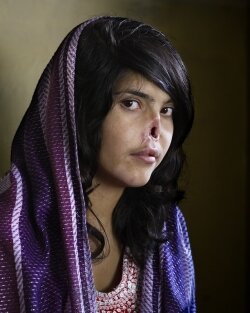World of hurt: Photographers wrench the gut
“If it bleeds, it leads” is the blunt if gruesome guiding principle of newsrooms everywhere. So it’s not shocking many of the winning images in the “World Press Photo 11” exhibit, premiering in North American at Look3, depict violence and death. But that’s no excuse not to see the photographs, which represent the best photojournalism from around the globe.
Staged in the McGuffey Art Center’s upstairs and downstairs hall galleries, the exhibit encompasses images culled from 108,059 submissions by 5,691 photojournalists from 129 countries, selected both for their aesthetic and narrative strength.
Some of the images are unbearably sad, such as French photographer Olivier Laban-Mattel’s shot of a white uniformed morgue worker tossing a child’s corpse— captured in midair like a flung doll— onto a pile of dead bodies following the Haitian earthquake. Others are surprisingly lyrical, like American Benjamin Lowy’s abstract pictures of oil-contaminated waters off the Louisiana coast following the Deepwater Horizon disaster.
The show opens with the World Press Photo of the Year, South African photographer Jodi Bieber’s “Bibi Aisha,” which many will recognize as a Time magazine cover. Recalling Steve McCurry’s iconic portrait of an Afghani girl, Bieber’s photograph also depicts a young Afghani woman in three-quarter view, eyes looking directly into the lens. But in Bieber’s image, a hole gapes at the center of the woman’s face— the Taliban having chopped off her nose and ears as punishment for fleeing her abusive husband. Although disturbing, the photograph is stunning, with the pink scar tissue and mauve color of the woman’s lips subtly echoing the striped purpled shawl draped over her head.
Although the squeamish should steer clear of the north end of McGuffey’s upstairs hall gallery (trust me), the middle and south end offer lighter fare for the emotionally drained, showcasing World Press Photo’s winners in the categories of Nature, Sports, and Arts and Entertainment. Which isn’t to say there isn’t gore— literally in the case of Gustavo Cuevas’s shot of a matador impaled on the horn of a bull, as his blue and red cape swirls in the center of the frame. But there are also easier images, like Amit Madheshiya’s charming portraits of spectators viewing traveling cinema shows in India.
Startling and meaningful, the “World Press Photo 11” exhibit highlights the power of photography to inform and effect change. See the photos. Then have a stiff drink.
Presented by Look3: Festival of the Photograph, the “World Press Photo ‘11” exhibit makes its North American premiere at the McGuffey Art Center through June 26. An opening reception is scheduled for June 9, 5-6pm. 201 Second St. NW. 977-3687.

1 comment
Then why are there no pictures of the victimes of Joseph Kony aka "worst person in the world"?